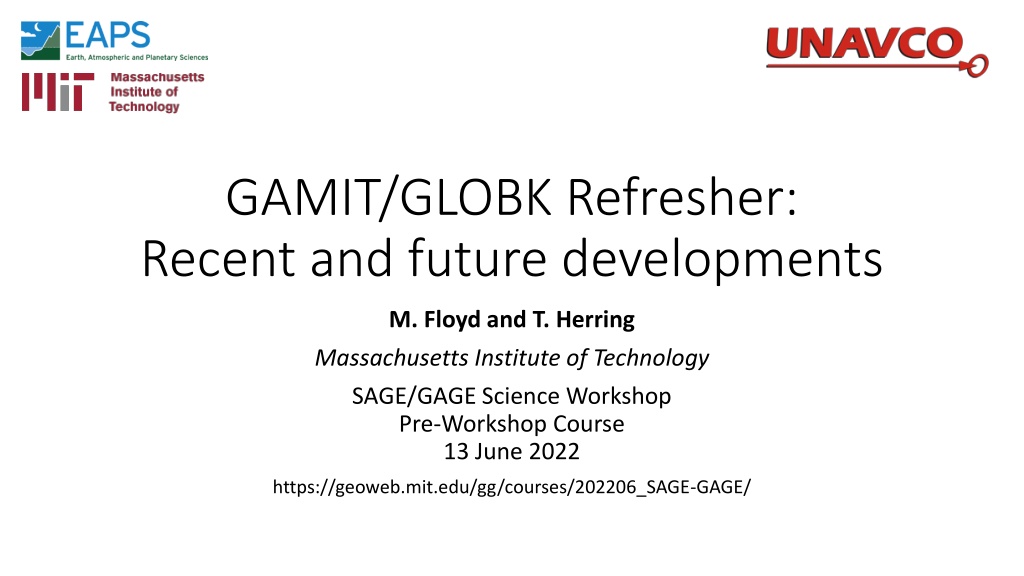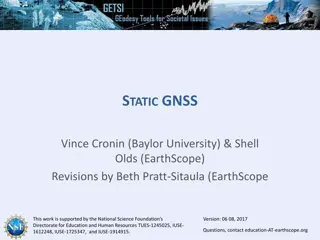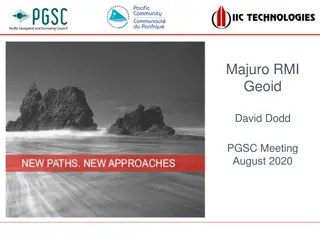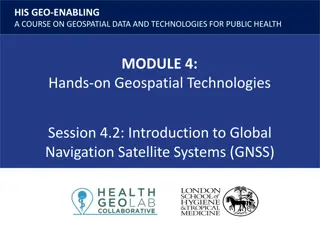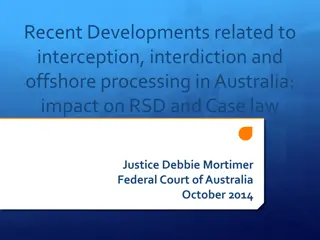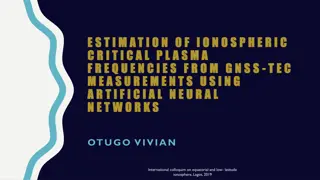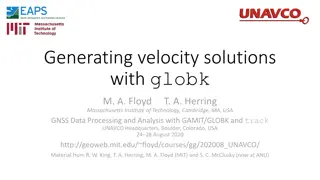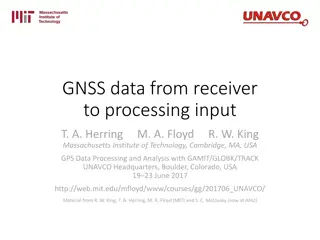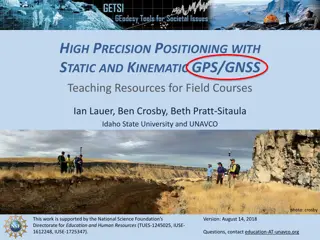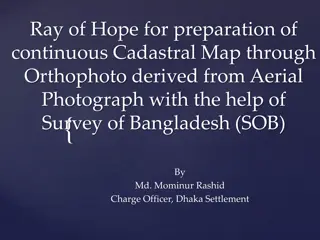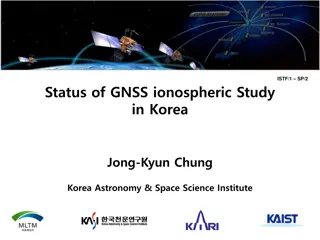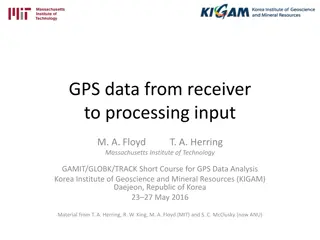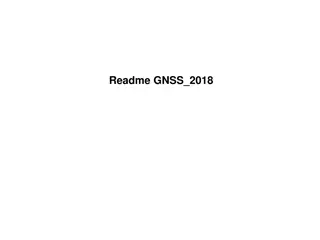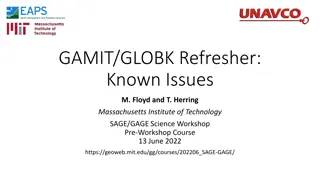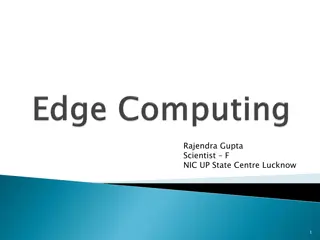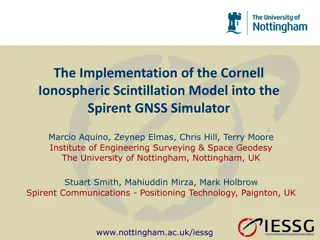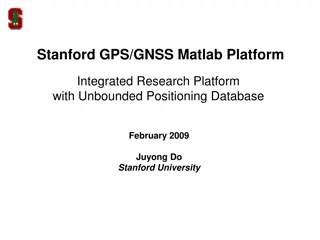Recent Developments in GAMIT/GLOBK for GNSS Processing
Significant updates and future developments in GAMIT/GLOBK for GNSS processing include processing of multiple constellations independently, transition to secure HTTP for code distribution, addition of azimuth field for station alignment, and regular updates schedule. Higher-order ionosphere and rapid processing methods are also discussed.
Download Presentation

Please find below an Image/Link to download the presentation.
The content on the website is provided AS IS for your information and personal use only. It may not be sold, licensed, or shared on other websites without obtaining consent from the author.If you encounter any issues during the download, it is possible that the publisher has removed the file from their server.
You are allowed to download the files provided on this website for personal or commercial use, subject to the condition that they are used lawfully. All files are the property of their respective owners.
The content on the website is provided AS IS for your information and personal use only. It may not be sold, licensed, or shared on other websites without obtaining consent from the author.
E N D
Presentation Transcript
GAMIT/GLOBK Refresher: Recent and future developments M. Floyd and T. Herring Massachusetts Institute of Technology SAGE/GAGE Science Workshop Pre-Workshop Course 13 June 2022 https://geoweb.mit.edu/gg/courses/202206_SAGE-GAGE/
Significant updates GAMIT/GLOBK and track process GPS, GLONASS, Galileo and BeiDou as of version 10.61 Constellations are processed independently and combined in GLOBK (use ambiguity-free version of binary h-file, e.g. *.glr, for GLONASS) Transition from FTP to secure HTTP for distribution of source code Use https://chandler.mit.edu/gps/ instead of ftp://chandler.mit.edu/updates/ Username and password are the same Transition from FTP to HTTP for downloading data and products sh_get_rinex has the following archives hard-wired (i.e. ~/gg/tables/ftp_info is ignored) to use HTTP: CDDIS, Geoscience Australia Addition of Quick Start Guide document https://geoweb.mit.edu/gg/docs/GG_Quick_Start_Guide.pdf Switch of provider of atmospheric pressure loading grids Formerly GGFC (https://geophy.uni.lu/atmosphere/ncep-loading/) based on NCEP atmospheric pressure fields Soon also ESMGFZ (http://esmdata.gfz-potsdam.de:8080/repository/entry/show?entryid=80daee1b-ff73-481f-b0f3- 18026282c03e) or VMF (https://vmf.geo.tuwien.ac.at/APL_products/GRID/), based on ECMWF atmospheric pressure fields Azimuth field added to station.info (e.g. ~/gg/tables/station.info.dAZ) for use when antennas are not aligned properly to true north
Keeping up with updates Updates are always covered in detail in two places: Release notes upon release of a new version of GAMIT/GLOBK (once every few years), e.g. https://chandler.mit.edu/gps/source/relnote.10.71 README included with incremental_updates tar-file or the equivalent text on our Updates web page (https://geoweb.mit.edu/gg/updates.php) We now have a regular incremental updates schedule where the tar- file is generated on the first of each calendar month Individual incremental updates are available immediately in the https://chandler.mit.edu/gps/updates/incremental_updates/ directory, which is what is tar d at the beginning of each month
GNSS processing -gnss option in sh_gamit command If processing non-GPS data, choose multi-GNSS orbit, e.g. -orbit codm Process each constellation separately By default, without any -netext option, the constellation code will be appended to the day directory name Combine in GLOBK tr_gnss option in track command file Constellations may be processed simultaneously but influence of inter-system biases is not clear
Higher-order ionosphere and rapid processing Default is now to use higher-order ionosphere by downloading and processing with an IONEX file Ion model = GMAP in sestbl. Implicit -ion igsg (final IGS IONEX product) with sh_gamit Similar to implicit -orbit igsf to use IGS final orbits if option not given explicitly If doing rapid processing (within a few days of the current date) Include explicit -ion igrg option (rapid IGS IONEX product) with sh_gamit Switch off higher-order ionosphere with Ion model = NONE in sestbl.
Transition to HTTP from FTP: Source code FTP scheme (will be discontinued) ftp://chandler.mit.edu/updates/ HTTP scheme (now available) https://chandler.mit.edu/gps/ Username and password are the same This again enables interaction and download with the source code server directories and files via a web browser Suggested shell commands to automate or batch downloads are in Section 3 of the Quick Start Guide, e.g. curl -R -O -u <username>:<password> 'https://chandler.mit.edu/gps/source/{com,gamit,help,kf,libraries,tables,test_install}.10.71.tar.gz curl -R -O -u <username>:<password> https://chandler.mit.edu/gps/source/incremental_updates.<YYYY><MM>01.tar.gz The server s secure certificate may not be fully recognized yet, so add the -k option to curl or --no-check-certificate option to wget if you experience problems
Transition to HTTP from FTP: Data and products sh_get_rinex is now hard-wired to download data and products via HTTP from the following servers: BKG; CDDIS; NOAA (NGS) CORS; GeoNet NZ; Geoscience Australia; SOPAC; UNAVCO Ignore any remnant messages about FTP server address, username, password, etc. These are the same messages as you would previously see but are now overridden by the hard-wired server information Set up your .netrc for at least CDDIS (NASA Earthdata login) and SOPAC (anonymous with email for password) to facilitate downloads See Section 2.5 of the Quick Start Guide for more information There are likely to be similar changes in the future, so keep checking the updates web page, e.g. More servers transitioning to HTTP from FTP Other servers implementing user authentication (likely at least UNAVCO)
Transition to HTTP from FTP: sh_get_* scripts We plan to rewrite and consolidate the sh_get_* scripts for this FTP-to-HTTP transition into a single sh_download script This is under development and will be fully backwards compatible with the current sh_get_* scripts
Addition of antenna azimuth to station.info Some (many?) antennas are not set correctly to be aligned to true north We have introduced an optional field in station.info to account for these antennas with an azimuth value This will be used to rotate the phase center offset (PCO) and phase center variation (PCV) models in ~/gg/tables/antmod.dat into alignment with the actual site antenna s orientation See ~/gg/tables/station.info.dAZ for template
Release and details of ITRF2020 Released on 2022-04-15 (e.g. [IGSMAIL-8191] ITRF2020 is available on line ; https://lists.igs.org/pipermail/igsmail/2022/008187.html) For the first time, includes seasonal signals, in the form of periodic terms, which are provided relative to both the Earth s center of mass and center of figure Official definition of geocenter motion provided to convert to center of figure (https://itrf.ign.fr/ftp/pub/itrf/itrf2020/ITRF2020-geocenter-motion.dat) This is now an important distinction, since the relative motion of the two definitions of the geocenter is almost entirely seasonal, which may affect decisions and interpretation of results, particularly time series when studying seasonal signals Two files will soon be made available in ~/gg/tables/: itrf20m.apr (center-of-mass reference frame) itrf20f.apr (center-of-figure reference frame) These will eventually form the basis of a new default .apr-file, e.g. ~/gg/tables/lfile.apr Can be removed with appending -PER to file name with apr_file option in globk/glorg command file, e.g. apr_file itrf20m.apr-PER
